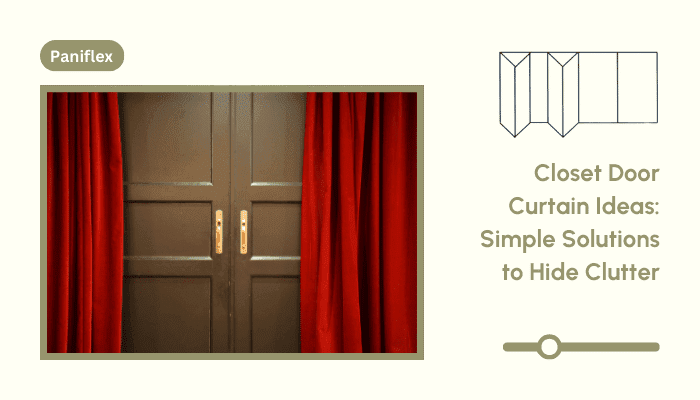As an interior designer or architect, you constantly seek innovative ways to transform spaces. Regarding closets, the challenge often lies in balancing functionality with aesthetics. Enter closet door solutions curtains – a versatile and elegant alternative to traditional doors that can elevate any room’s design while effectively concealing clutter.
In this guide, we’ll explore creative and practical methods for using curtains as closet doors. This will enhance space aesthetics and offer your clients a unique design element. Whether working on a minimalist apartment or a luxurious home, these ideas will inspire you to think beyond conventional closet doors and open up new design possibilities.
Ready to experience the benefits of custom closet doors? Explore our range of Paniflex products now.
Types of Closet Door Curtains
1. Curtains or Drapes
When considering closet door solutions curtains, traditional curtains or drapes offer endless possibilities. You can install them using tension rods for a temporary solution or wall-mounted rods for a more permanent fixture. The variety of colors, textures, and patterns allows you to complement any room’s decor perfectly.
Consider the following options:
- Floor-length drapes for a dramatic, luxurious look
- Cafe curtains for a casual, cottage-style aesthetic
- Layered curtains combining sheer and opaque fabrics for depth and versatility
- Velvet or silk for a touch of opulence in high-end interiors
- Linen or cotton for a relaxed, natural feel
Also Read: Different Closet Door Ideas For the Bedroom
Pro Tip: For clients seeking a custom look, consider Paniflex’s range of materials and finishes. While they specialize in sliding and bifold doors, their design principles can inspire your curtain choices, helping you create a cohesive look that aligns with the room’s overall aesthetic.
2. Beaded Curtains
For a touch of bohemian flair, beaded curtains are an excellent closet door solutions curtains option. They add texture and movement to the space while maintaining easy access to the closet’s contents. This choice is particularly suitable for eclectic or artistic interiors.
Explore these beaded curtain ideas:
- Wooden beads for a natural, organic look
- Crystal beads to add sparkle and glamor
- Metallic beads for a modern, industrial touch
- Colorful plastic beads for playful, vibrant spaces
- Mixed material beaded curtains for a unique, custom appearance
Also Read: Hallway Closet Door Ideas for Every Home
Now that we’ve explored different types of curtains, let’s delve into the importance of fabric selection, which can make or break your design.
Choosing the Right Fabric Material
1. Thick Woven Curtains
For clients prioritizing privacy and protection, thick woven curtains are ideal. These substantial fabrics conceal closet contents effectively and add a luxurious touch to the room.
Consider these options:
- Heavy cotton duck for durability and a casual look
- Wool blend for warmth and sophistication
- Jacquard for intricate patterns and a high-end feel
- Blackout curtains for complete privacy and light control
- Thermal curtains to help with temperature regulation in the room
2. Sheers
Sheer curtains offer a delicate, airy look that can make a space feel larger and more open. While they may not provide complete privacy, they’re perfect for creating a soft, diffused barrier in rooms where complete concealment isn’t necessary.
Explore these sheer options:
- Voile for a light, flowing appearance
- Chiffon for a delicate, romantic atmosphere
- Organza for a crisp, structured, sheer look
- Lace for vintage charm and subtle pattern
- Mesh for a modern, minimalist aesthetic
When selecting fabrics, consider light filtration, maintenance requirements, and how they complement the room’s textures. Remember, the suitable fabric can transform a simple closet into a design feature.
Also Read: 9 Types of Interior Doors for Your Home
With the fabric choices in mind, let’s move on to the hardware supporting your chosen curtains, an often overlooked but crucial design element.
Hardware Selection and Installation
1. Curtain Rods
Selecting the right curtain rod is crucial for both functionality and aesthetics. When choosing rods for your closet door solutions curtains, consider factors like weight capacity, finish, and design
Critical considerations for curtain rods:
- Material: Choose from metal, wood, or plastic based on the overall design theme
- Finishes: Options like brushed nickel, oil-rubbed bronze, or painted finishes to match or contrast with room decor
- Decorative finials: Add personality with unique end pieces
- Extendable rods: Offer flexibility for different closet widths
- Double rods: Allow for layering of curtains for added depth and functionality
2. Curtain Tracks
Curtain tracks offer smooth operation and a clean aesthetic for a sleek, modern look. They’re particularly effective for large closet openings or when a minimal hardware appearance is desired.
Explore these track options:
- Ceiling-mounted tracks for a seamless look
- Flexible tracks for curved or unusual closet shapes
- Motorized tracks for high-end, automated solutions
- Low-profile tracks that disappear behind curtain headers
- Heavy-duty tracks for exceptionally large or heavy curtains
Designer Insight: While Paniflex specializes in custom closet doors, their emphasis on smooth operation and precision can inspire your hardware choices for curtain solutions. Consider how their sliding mechanisms could influence your track designs for ultra-smooth curtain movement.
Also Read: Simple Methods to Trim the Bottom of a Door
Now that we’ve covered the practical aspects, let’s explore how to make these curtains genuinely shine in your design, turning them from mere closet covers into statement pieces.
Design and Aesthetic Considerations
1. Neutral Palette
Choose curtains in neutral tones that blend with the room’s existing color scheme for a seamless look. This approach allows the closet area to integrate harmoniously with the overall design.
Tips for working with neutrals:
- Use textured neutrals to add depth without color
- Incorporate subtle patterns like herringbone or pinstripes for interest
- Mix different shades of the same neutral for a layered look
- Add metallic threads or accents for a touch of luxury
- Combine different neutral materials for textural contrast
2. Contrasting Colors and Patterns
Alternatively, use curtains as a statement piece for the closet door solutions. Bold patterns or contrasting colors can draw attention and add character to the space, turning the closet into a focal point of the room’s design.
Ideas for statement curtains:
- Geometric patterns for a modern, dynamic look
- Floral prints to bring nature indoors
- Color blocking for a contemporary artistic statement
- Ombre effects for a soft, gradual color transition
- Custom-printed curtains featuring artwork or photographs
When choosing between neutral and statement curtains, consider the room’s overall design, the client’s personality, and the space’s function. A bold choice in a minimalist room can create a stunning focal point, while neutral curtains in a busy space can provide a restful visual break.
Also Read: Expert Guide: Door Hardware Installation for Modern Design Professionals
With these design principles in mind, let’s look at some practical tips for bringing your vision to life and ensuring that the final installation is as impeccable as your design.
Practical Tips for Installing Closet Door Curtains
1. Measure the Closet Opening
Accurate measurements are crucial for a polished look. Ensure you account for any overlap needed to conceal the closet contents fully.
Measurement guidelines:
- Width: Measure the entire width of the opening and add 4-8 inches on each side for overlap
- Height: Measure from the rod placement to the floor, adding 1-2 inches for clearance
- Consider fullness: Multiply the width by 1.5-3 times for proper gathering, depending on the desired look
- Account for hardware: Factor in the space needed for brackets, rings, or clips
2. Selecting and Installing Rods
It would help if you chose rods that complement the room’s hardware and can support the weight of your chosen curtains. Securely installing the rods is critical to ensuring longevity and smooth operation.
Installation tips:
- Use a level to ensure perfectly straight rod placement
- Install support brackets every 30-50 inches for heavy curtains
- Choose wall anchors appropriate for your wall type (drywall, plaster, etc.)
- Consider using a template for consistent bracket placement
- Test the stability of the rod before hanging curtains
3. Accessories
Accessories like tiebacks or holdbacks enhance both function and style. These elements can add a decorative touch while providing practical benefits.
Accessory ideas:
- Decorative tiebacks: Use ropes, tassels, or sculptural pieces
- Magnetic holdbacks for a clean, modern look
- Curtain clips for easy opening and closing
- Curtain weights for a crisp, hanging edge
- Decorative curtain rings for added visual interest
Remember, the right accessories can elevate your curtain design from functional to fabulous, adding sophistication to your closet solution.
Also Read: Master Bedroom Custom Closet Installation and Design
While these tips apply to most spaces, children’s rooms require special considerations to ensure style and safety.
Special Considerations for Children’s Rooms
1. Safety and Accessibility
When designing children’s spaces, prioritize safety and ease of use. Choose lightweight fabrics and ensure the installation allows easy access without injury risk.
Safety considerations:
- Avoid long cords or strings that could pose a strangulation hazard
- Use breakaway curtain rods that detach if weight is applied
- Opt for washable fabrics to maintain hygiene
- Choose curtains with tab tops or large grommets for easy sliding
- Consider motorized options for very young children or those with mobility issues
2. Additional Storage
To maximize organization in children’s rooms, consider combining curtain solutions with additional storage options like cubbies or chests of drawers.
Storage ideas:
- Install a low rod with curtains and place cubbies above
- Use a curtained closet area for more oversized items and add drawer units for smaller belongings
- Incorporate pocket organizers on the back of curtains for extra storage
- Combine a curtained closet with an open wardrobe system for frequently used items
- Use decorative boxes or baskets behind curtains for attractive, accessible storage
By thoughtfully addressing safety and storage, you can create a closet solution that grows with the child, adapting to their changing needs over time.
Ready to experience the benefits of custom closet doors? Explore our range of Paniflex products now.
Conclusion
Closet door solutions curtains offer a versatile, stylish alternative to traditional closet doors. By carefully considering fabric choices, hardware options, and design elements, you can create stunning, functional spaces that perfectly align with your clients’ needs and aesthetic preferences.
Remember, while curtains provide flexibility and style, some clients may prefer more structured solutions. In such cases, don’t hesitate to explore custom options like those offered by Paniflex. Their range of personalized closet doors could be the perfect fit for projects requiring a more traditional approach with a modern twist.
Ready to elevate your closet designs? Whether you choose the soft elegance of curtains or the precision of custom doors, the key is in the details. Transform your next project with these innovative closet solutions along with Paniflex, and watch as form and function blend seamlessly into your designs. By thinking outside the box and considering alternatives like curtains, you can offer your clients unique, personalized spaces that reflect their style and meet their practical needs.






